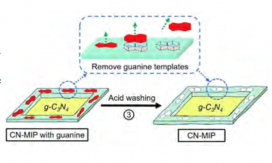Innovative Trap-and-Zap Materials Enhance Photocatalysts to Improve Water Safety
Researchers at the National Science Foundation (NSF)-funded Nanotechnology Enabled Water Treatment (NEWT) Engineering Research Center (ERC) have successfully completed lab-scale testing of molecular imprinted graphitic carbon nitride for selective photocatalytic removal of extracellular antibiotic resistant genes (ARGs). And by using a β-cyclodextrin polymer—or CDP—with fluorinated monomers, the NEWT team at Rice University synergized the photocatalysis of bisphenol A (BPA) for removal, thereby extending the lifetime of surface modification.
Two common limitations of photocatalytic water treatment include inefficiencies associated with the scavenging of reactive oxygen species by non-target water constituents and the loss of functionalities due to the decomposition of surface organic modification. NEWT’s “Trap-and-Zap”-style polymers are multifunctional nanomaterials that can target common water pollutants, such as ARGs or BPA, and remove them to better reinforce the stability of surface modifications and to prolong the activity and durability of other healthy photocatalysts. For example, ARGs are often released into wastewater treatment plant effluent, which then gets stabilized by clay in receiving environments and transforms indigenous bacteria into Resistome reservoirs. If left unmanaged, ARGs can reduce the effectiveness of some medications. Similarly, BPA has been found to mimic estrogen-like properties that can interfere with hormones, prompting concerns about the health safety of plastics used in or around drinking water.
A carbon nitride-based photocatalyst with molecularly-imprinted coatings was chosen by the NEWT team to enhance selectivity and minimize interference by background organic compounds. Molecular imprinting with guanine enhanced ARG adsorption, which improved utilization of photogenerated oxidizing species to degrade the ARGs, rather than being scavenged by background non-target constituents. Consequently, photocatalytic removal of an ARG in secondary effluent with MIP-C3N4 was 37 times faster than with bare graphitic carbon nitride under UVA irradiation. Overall, MIP-C3N4 efficiently removed ARG from secondary effluent, demonstrating the potential for molecular imprinting to enhance the selectivity and efficacy of photocatalytic processes to mitigate the dissemination of antibiotic resistance from sewage treatment systems.
Synthesized fluorine containing porous CDP used as a surface coating on titanium dioxide (TiO2) hierarchical spheres are easy to separate and reuse by low-pressure filtration. CDP has a prolonged lifetime at more than 1000 hours in a photocatalytic system and can successfully trap BPA and possibly other endocrine disruptors near photocatalytic sites for more efficient destruction.



